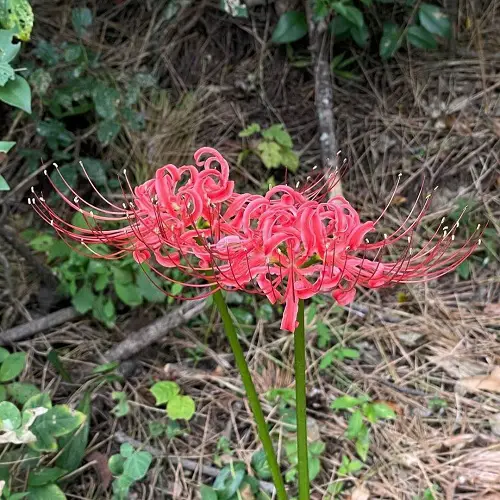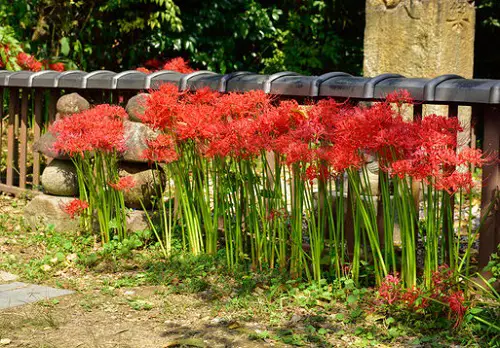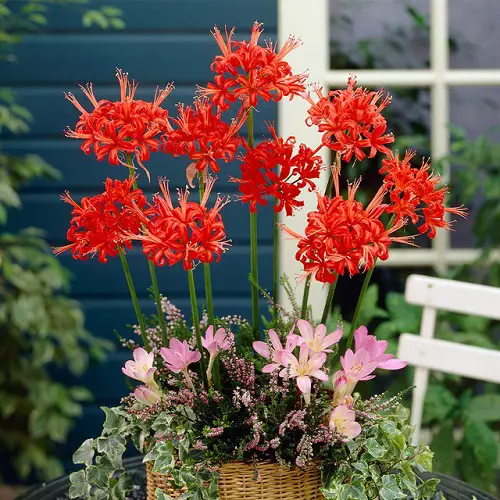Red Spider Lily is a beautiful plant that looks great indoors and in the garden! Here’s all the information you need to grow it.
Red Spider Lily, also known as Lycoris radiata, is a beautiful and unique flower that is native to Asia. These flowers bloom in late summer and fall, and their bright red color and spider-like appearance make them a popular choice for gardens and flower arrangements.
Botanical Name: Lycoris radiate
USDA Zones: 5-10
Learn how to grow Leopard Lily
Red Spider Lily Information
The Red Spider Lily is a bulbous perennial flowering plant native to Japan, China, and Korea. It is a member of the Amaryllidaceae family and is popular for its striking red flowers, which are popular in Japan during the fall months.
The flowers are also famous for their exquisite fragrance. They are typically grown in gardens, and you can easily grow them by division or by planting seeds.
Note: It is a poisonous plant, so it should be handled with care and kept away from children and pets.
Red Spider Lily Meaning
Red Spider Lily is an iconic symbol of autumn in Japan, with its striking red flowers appearing after the summer rains. In Japan, the flower is famous as higanbana and people associate it with memories of the dead.
In the language of flowers, the red spider lily is sometimes said to represent loneliness and sadness.
Propagating Red Spider Lilies

With a little patience and care, you can successfully propagate the plant from division or bulbs and enjoy its beautiful blooms in your garden.
Division:
- Prepare the planting area by preparing soil and adding organic matter, such as compost.
- Dig up the clump of lilies, taking care to preserve as much of the root system as possible.
- Separate the clump into smaller sections using a sharp knife or spade.
- Plant the divisions in the prepared soil, making sure the crown of each division is at or just slightly below the soil surface.
- Water the newly planted divisions thoroughly.
- Fertilize the divisions with a balanced fertilizer to encourage healthy growth.
- Monitor the divisions for any signs of disease or pests and take appropriate action if needed.
Red Spider Lily can be propagated from bulbs. It is best done in the spring when the plant is actively growing.
Carefully dig up the bulbs, making sure to keep the roots and the soil intact. Separate the bulbs, keeping the larger ones for replanting and the smaller ones for propagation. Plant the bulbs in a pot of loose, well–draining soil. Water regularly and keep them in a warm, sunny spot. Within a few weeks, the bulbs will produce shoots.
Best Types of Red Spider Lily
The most common type of Red Spider Lily is the Lycoris radiata, which is also known as the Surprise Lily. This species of lily is a hardy, deciduous bulb that produces bright red flowers in the late summer and early fall. Other species of Red Spider Lilies include:
- Lycoris squamigera: Commonly known as the resurrection lily, it is a species of flowering plant in the amaryllis family. It produces stunning pink or white flowers in mid-to-late summer and is highly prized for its dramatic show.
- Lycoris aurea: Popular as the Golden Spider Lily, it is a species of flowering plant in the Amaryllidaceae family. The flowers are yellow and deeply cupped, with reflexed petals and a yellow center. It blooms in late summer and early fall.
- Lycoris sanguinea: It is native to parts of East Asia, including China and Japan, and produces bright red, trumpet-shaped flowers in summer and early autumn.
Learn all about growing Arum Lily
Requirements for Growing Red Spider Lily
Light
Red Spider lilies do not require direct sunlight in order to thrive. In fact, too much direct sunlight can be harmful to their delicate leaves.
These plants prefer bright, indirect light, and it would be a good idea to choose a location in the garden that gets indirect light throughout the day.
If you are planning to grow these indoors, make sure they get diffused light through a sheer curtain or window screen.
Soil
The ideal soil for growing the plant should be well-draining, high in organic matter, and slightly acidic. A good soil mix combines equal parts compost, peat moss, and perlite.
This will help ensure that the soil has good drainage while also providing the necessary nutrients for the plants to thrive. Also, it prefers slightly acidic soil with a pH of 5.5 to 6.5.
Watering
These flowers are drought-resistant, so they don’t need a lot of water. Water the plant deeply when the topsoil is completely dry. During periods of extreme heat or drought, water your plants more frequently, as they may need extra moisture to stay healthy.
Temperature and Humidity
Red Spider Lily requires a temperature range between 65 and 75 degrees Fahrenheit (18-24 degrees Celsius). Humidity levels should be between 50 and 75 percent for this plant.
Check out the best daylilies
Red Spider Lily Care
Fertilizing
It doesn’t require a lot of fertilizing – adding compost or organic matter while planting is enough!
If you want to boost the growth, use a slow-release fertilizer that is specifically available for bulbs, such as a 10-10-10 or 5-10-10 formulation. Apply it according to the instructions on the packaging.
Pruning
If you wish to keep the flowers blooming longer and the foliage looking neat, you can trim off dead or damaged leaves and cut away any spent flowers. Pruning should be done in the late winter or early spring when the plant is dormant.
Pests and Diseases
Pests:
1. Aphids: These small sap-sucking insects can be found on the leaves and stems of the red spider lily. They can cause damage to the plant by sucking out the sap and leaving behind a sticky residue called honeydew.
2. Slugs and Snails: These slimy pests feed on the leaves and stems of the red spider lily, leaving behind ragged holes in the foliage.
Diseases:
- Powdery Mildew: Caused by fungi in the Erysiphales order, this disease appears as a white powdery substance on the leaves and stems of the plant.
2. Bacterial Leaf Spot: Caused by the bacteria Xanthomonas axonopodis, this disease affects the leaves, causing yellow spots with a dark margin around them.
3. Fungal Leaf Spot: Caused by the fungus Colletotrichum coccodes, this disease causes small, round spots with a yellow halo on the leaves.
Quick Tips to Make Red Spider Lily Bloom Faster
- Plant the red spider lily in a sunny spot. These plants require full sun for at least six hours in order to bloom.
- Red spider lilies require moist soil to grow and bloom, so make sure to water it when the top inch or two of the soil is dry.
- Fertilize the red spider lily in the spring with a balanced fertilizer with an equal ratio of nitrogen, phosphorus, and potassium.
- Deadhead spent blooms. When the flowers die, cut the stem just below the bloom. This will help encourage the plant to produce more flowers.
How to Overwinter a Red Spider Lily?
- Bring the plant indoors before the first frost.
- Cut the stems back to just above the soil line.
- Place the plant in a warm, dry area with indirect light.
- Water the plant only when the soil is dry.
- Monitor for pests and treat them with an appropriate pesticide if necessary.
- Move the plant outdoors when the danger of frost has passed.
Is Red Spider Lily Poisonous?
Red Spider Lily is not poisonous but can be mildly toxic. It contains a compound called lycorine, which can cause an upset stomach, nausea, vomiting, and diarrhea if anyone is going to consume it in large amounts.
The plant also has a bitter taste and is not recommended for consumption.
Red Spider Lily Benefits
Despite its toxicity, the Red Spider Lily is popular for its uses in traditional medicine in Asia. Some practitioners believe that the plant has medicinal properties, including anti-inflammatory and anti-cancer effects.
You can use the plant to repel pests such as moles, rodents, and insects, making it a popular choice for natural pest control in gardens and farms.
However, there is little scientific evidence to support these claims, and using the plant for self-medicinal purposes is not recommended. There is still a need for more research – to understand the potential benefits of the red spider lily fully.
Can Red Spider Lily Kill You?
No, the Red Spider Lily cannot kill you. While the plant is toxic if ingested, it is not deadly and will not cause death. However, it’s always important to err on the side of caution and seek medical attention if you experience any adverse symptoms after coming into contact with or ingesting the plant.







